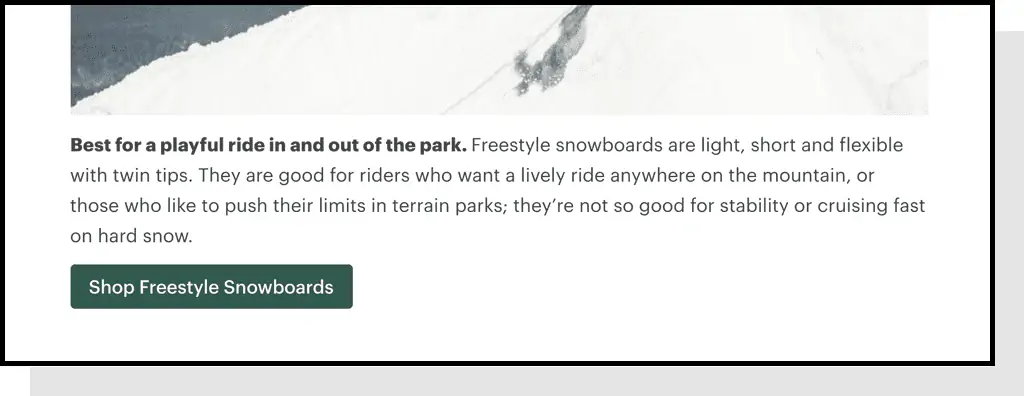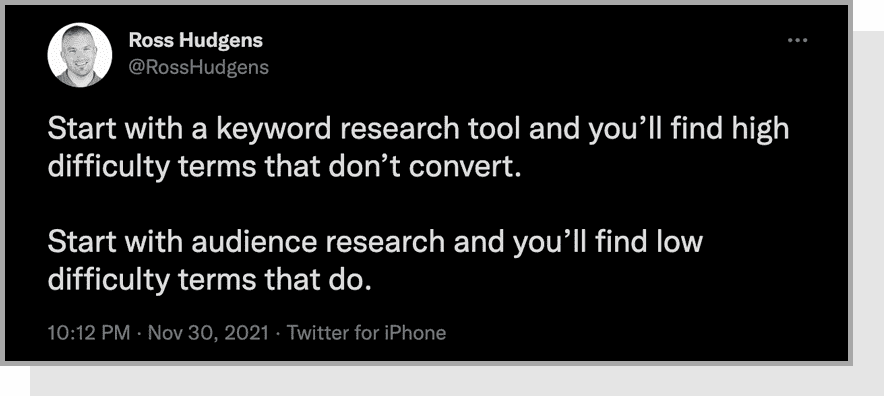Traffic is nice, but sales are better.
Tired of creating content that gets lots of eyeballs on your brand, but does little to actually generate outcomes? You’ve come to the right place to change that.
Siege Media has experience creating content for customers that only had 286 visits, but managed to generate over $195,000 in sales.
In this guide, we’ll walk you through the step by step process of creating high-converting content. We’ll jump through CRO for blog content (what makes a great blog post), ideal content strategy, and how to measure and iterate to generate even more conversions.
We promise you’ll leave with a few more (knowledge) bucks in your pocket to implement.
CRO Best Practices for Blogs
Many businesses mess up their conversion rate simply by treating their blog like a magazine. Your blog is not a magazine, it’s meant to drive sales.
With that mindset shift in place, you’re ready to actually drive real results and conversions from content you create.
1. Sticky Navigation with Contrasting CTA
The careful balance we have to walk on our blog is driving sales, but not being so aggressive it makes users bounce.
A narrow, sticky navigation with a classy, contrasting call-to-action (CTA) button is a perfect balance as users can convert at any time, but don’t have the experience impact their reading. On mobile, having this be sticky but minimalistic as well is recommended.
What the CTA is depends on your business type. Often, a free trial, sale, or shop now button can be used. Definitely, this is most natural for SaaS companies who have a single action you want users to take (sign up for the tool), but can be done for e-commerce companies as well.
2. Blog Inherits the Main Navigation
Adding to the navigation being sticky, having the blog or content section share the main navigation is important as well.
This offers users a natural shopping experience with lower friction, as compared to only being shown blog categories. Additionally, this structure offers internal linking benefit as your blog will often be your most linked to section on the site.
This will send equity flow to your most important pages, helping them rank better. So even if your blog doesn’t drive sales directly, you’ll at least have a stronger argument that it will at least do that indirectly.
3. Classy “Shop” Buttons on Middle-Funnel Content
Some content doesn’t make sense to live on a landing page, but is close to a conversion, such as REI’s “how to buy X” pages.
In these instances, classy “shop” buttons in-content make sense. They don’t push the sales too hard, but clearly draw the attention of the reader and because of that, are more likely to draw an action.
4. Include a Mid to Late Post Visual CTA
It doesn’t hurt, especially if it’s contextual, to include a visual call to action for your product. In an ideal world, it’s like the shop button of REI – it makes sense and is customized for the post, but that isn’t always possible.
The above example of Gusto walks a nice balance, not being too obtrusive, but still catching your attention. Having this appear 50% or more down the page is the right balance to still try to drive users, but not cause them to bounce by making your site feel like an ad.
5. Put Text CTAs on an Island
Sometimes, a simple text link can be wildly effective. The key is to make that text link live on an island, so it still stands out to the user.
Many users will scan posts and not pay attention to links within paragraphs, or even read paragraphs. Using a simple sentence with a text link CTA will stand out. For maximum points, include one of these at the end of every post, and 1-2 more mid-post where it makes sense.
High-Converting Content Strategy
High-converting content isn’t just a matter of setting your site up for conversion success. It’s also creating content that maps to actual buyer intent.
Beginner content marketers may look at high search volume terms with starry eyes, but the reality is nine times out of ten, these terms don’t convert. You want to go in the direction of conversion, which is often low search volume.
1. KOB Analysis
The first consideration to make is that you should use traffic value or an equivalent metric as your primary indicator of value. These metrics look at what people are bidding on the same traffic you’re receiving from search. So if you know it’s a true competitor, and you can also rank for it, there is a strong chance of conversion.
We go further with this via our Keyword Opposition to Benefit (KOB) Analysis. View the following video for a larger breakdown of how to use this to your advantage.
2. Keyword Frameworks
Although traffic value and KOB analysis are great methodologies for driving conversions, it won’t always capture buyer intent that exists with low search volume terms. This is especially the case in niche B2B verticals.
For this reason, you want to lean on tried-and-true keyword frameworks that often convert. Here are some examples that consistently drive sales, as they map to when users are late in their purchase consideration journey.
- PRODUCT cost
- PRODUCT vs. PRODUCT
- KEYWORD template
- INDUSTRY JARGON
- COMPETITOR vs. you
- COMPETITOR alternatives
- What is INDUSTRY JARGON
The data in the above screenshot is one example of these frameworks in practice. Ahrefs or SEMRush didn’t register search volume, but they generated real buyer intent.
3. Start With Audience Research
Many marketers make the mistake of starting with keyword research tools to come up with content ideas. As the tweet above describes, this will actually lead you to some of the worst outcomes.
The reason for this is that you are using words, not consumer psychology to drive your actions. Additionally, these tools will surface the highest volume terms, and these terms are the same things everyone sees. This leads to a high likelihood that these topics will both have high competition and low conversion rate.
By putting yourself in your users shoes before resorting to a keyword research tool, you can best replicate the actual conversion path they might take.
Get to know your users with some of the following processes:
- Deeply get to know your product to understand what problems it solves.
- Access or develop buyer persona documentation.
- Listen to sales calls or demos and read email form submissions to learn how customers think and talk.
- Ask for and/or record common questions you get in the sales process.
- Use Sparktoro for introductory research. Sparktoro allows you to quickly find relevant blogs, podcasts and influencers relevant to your industry.
- Practice diversity, equity, and inclusion (DEI) in your content development.
Use Data to Adjust Strategy
Once you have your site setup to convert blog content and are creating content you think will convert, you can now take things further and make sure your content strategy is actually delivering what you expected.
Our general recommendation is to wait six or so months before going deep on adjusting strategy. You’ll need time to see things start to rank, and also time to get statistical significance.
The following are our recommended steps to analyze your data:
1. Get Goals Properly Setup in Analytics
Before analyzing data, make sure you’re tracking the right data. For blog content, it’s not always as simple as tracking direct sales. Blog content can sometimes touch users dozens of times before they convert. As content marketers, we should take credit for that.
Complex attribution modeling is outside the scope of this post, but overall we would suggest tracking secondary sales intent such as interactions with sales pages or case studies, eBook downloads and email signups.
2. Look at a Long Data Timeline
With content, it’s hard to get to true statistical significance given variable time ranges. However, you can get close with a solid sample size, but one that isn’t too long.
We’d generally suggest trying to get to three and a half months of data. Overall, if your content is receiving over 500 visits, you should be able to get some confidence in what you’re looking at.
3. Evaluate Goal Conversion Data
Now that you have a good sample size, you can start looking at your data. Here are some questions you’ll want to ask yourself looking at it:
- What content is converting strongly despite low views?
- Are there any themes in successful content types?
- What content *isn’t* performing well that we thought would?
- Are there similar post frameworks with significantly different conversion data?
Recording these insights can help you better create an action plan for the next step.
4. Adjust Content Strategy
These insights should give you several potential adjustments to make or look further into, including but not limited to:
- What content types should we prioritize doing more or less of?
Here, we may see certain content types are really converting poorly, and doing nothing else positive for us. For this reason, we may want to put future content plans for content of this type lower in our priority list.
- Are there any pages that look off (or on) in their conversion rate?
In looking at the aggregate data, we should see clear winners and losers in conversion rate. Using this information, dig deeper to see if there is something one post is doing that the other isn’t. This will be an educated guess, but it’s possible if you port over the successful structure of one post to another, you’ll see similar results.
Additionally, if you see a page with a conversion rate better than 10%, this is actually a solid signal that the page should be a landing page, not a blog post.
Consider moving the content to a landing page experience, as the data is telling you that users *want* to convert, but you’re not giving them a high-converting experience.
- What content should we prioritize in the site architecture?
If you know some content is performing especially well from a conversion standpoint, we want to get it front of users more often. To do that consistently, we can put it higher or more consistently in the site architecture.
This allows users to see it more often, with the thought process that more views equals more conversions. Additionally, better internal linking for this content also helps it rank higher, driving more views through search.
- Does any data in the KOB Analysis need to be adjusted?
Our initial KOB analysis process is great for identifying high value topics, but at the end of the day it is still an educated guess.
We should use the data from six months of work to adjust the traffic value numbers for content we plan to create to be closer to what we think actual value will be, once we have enough sample size to be confident in those adjustments.
Sales Over Everything
Don’t be a content marketer that just generates impressions. Generate sales. The above process is a tried and true method for doing that, time and time again.
Prefer to outsource the work? Reach out to hear more about our high-converting content marketing services.












